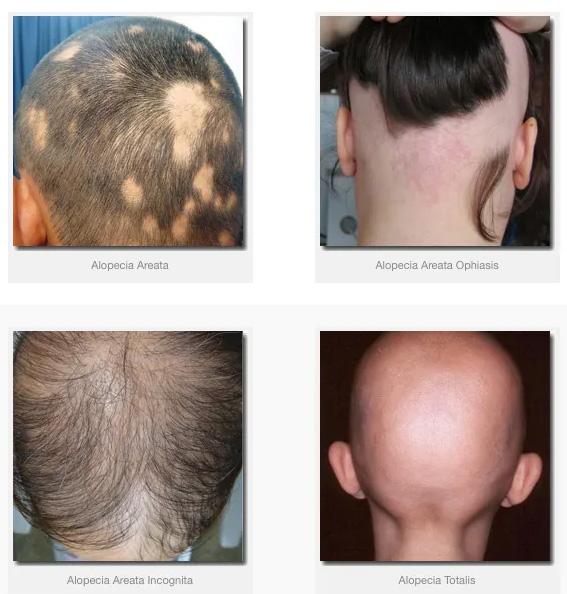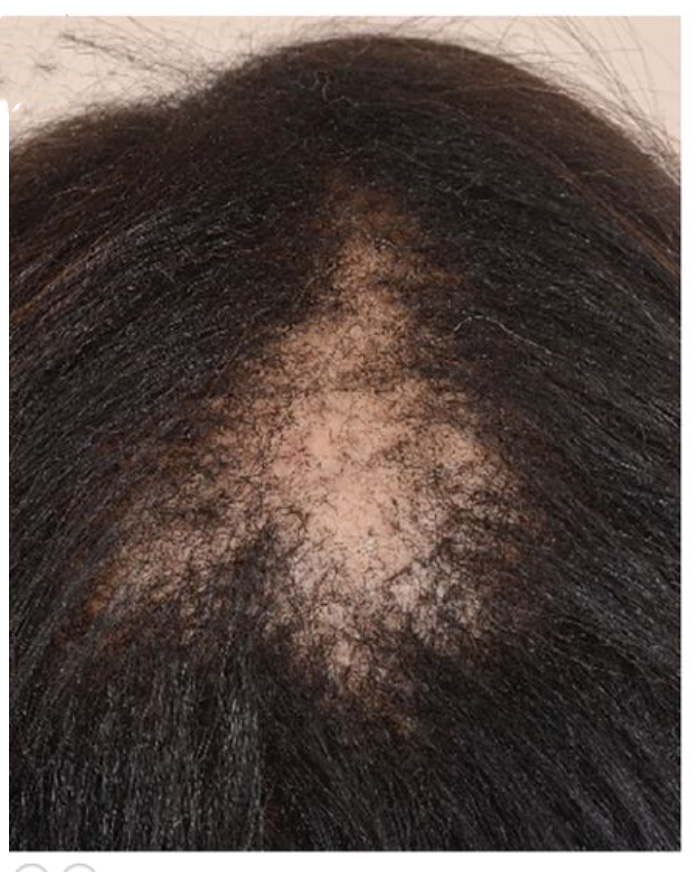Lorem ipsum dolor sit amet, consectetur adipiscing elit. Mauris pharetra arcu ac tempor malesuada. Maecenas rutrum elementum mi ut consectetur. Ut risus neque, egestas vitae eros a, mollis malesuada nibh. Etiam sit amet ultrices urna, vel venenatis augue.
Male and Female Patter Hair Loss
Male and Female Patter Hair Loss
- Pattern hair loss is the most common type of hair loss in both men and women.
- Scalp hair is commonly impacted in a specific pattern, without any additional scalp or dermatologic observations.
- Pattern hair loss, found in both males and females, is progressive but not scarring. Men typically experience it in the temporal, frontal, and vertex regions of the scalp, while women tend to be affected in the central scalp area.
- Pattern hair loss is a progressive condition that leads to a reduction in hair density for affected individuals. In the case of male pattern hair loss, certain areas may experience complete hair loss, while female pattern hair loss seldom progresses to baldness.
- The characteristic hair distribution in male and female hair loss follows the following pattern.

Many Different Names
This condition is known by several names, including androgenetic alopecia, androgenic alopecia, male balding, male pattern hair loss, female pattern alopecia, diffuse alopecia in women, and hereditary alopecia. The term “androgenetic alopecia” was historically used due to its recognition of the hormonal and hereditary factors contributing to the condition in men.
As our knowledge of both the underlying mechanisms and the visible manifestations grew, so did the assortment of terms used to describe this disorder. More recent terminology emerged to better capture the distinct patterns of hair loss seen in men and women, as well as the uncertain role and frequent absence of androgen excess in women. Consequently, “male pattern hair loss” and “female pattern hair loss” are now the preferred terms to denote these variations.
Causes for Male and Female Pattern Hair Loss
Genetics: The condition is inherited from both the mother and father’s side of the family. Specific genes play a role in determining the sensitivity of hair follicles to dihydrotestosterone (DHT), a hormone derived from testosterone.
Hormones: DHT is a byproduct of testosterone, and it plays a significant role in male pattern hair loss. Hair follicles in individuals with this condition are genetically sensitive to DHT, which causes them to shrink over time. As the hair follicles shrink, the growth phase of the hair becomes shorter, leading to progressively finer and shorter hair. Eventually, the hair follicles may stop producing new hair altogether, resulting in baldness in certain areas.
Age: Male pattern hair loss tends to become more noticeable and prevalent with age. While it can start as early as the late teens or early twenties, it is most commonly seen in men over the age of 50.
Other Factors: While genetics and hormones are the primary causes of male pattern hair loss, other factors such as stress, certain medications, and underlying medical conditions can exacerbate the condition or accelerate the hair loss process. However, they are not the underlying cause.
Other Pattern Hair Loss
Other types of alopecia can exhibit similar presentations to male and female pattern hair loss. These include telogen effluvium, alopecia areata, traction alopecia, trichotillomania, central centrifugal cicatricial alopecia, lichen planopilaris, and frontal fibrosing alopecia.
Telogen effluvium
Telogen effluvium is a type of temporary hair loss condition characterized by an increased shedding of hair. It occurs when a significant number of hair follicles simultaneously enter the telogen phase of the hair growth cycle, which is the resting phase. Normally, around 10-15% of our hair is in the telogen phase at any given time, but in telogen effluvium, this percentage increases significantly.
There are several potential triggers for telogen effluvium, including:
Physical or emotional stress: Severe stress, trauma, surgery, illness, or emotional distress can disrupt the normal hair growth cycle and lead to telogen effluvium.
Hormonal changes: Pregnancy, childbirth, menopause, or hormonal fluctuations can cause temporary hair loss in some individuals.
Medications: Certain medications, such as those used in cancer treatment (chemotherapy), retinoids, beta-blockers, anticoagulants, and some antidepressants, can induce telogen effluvium as a side effect.
Nutritional deficiencies: A lack of essential nutrients, particularly iron, zinc, biotin, or protein, can contribute to hair shedding.
Rapid weight loss: Drastic weight loss or extreme diets may trigger telogen effluvium.
Thyroid disorders: Both hyperthyroidism (overactive thyroid) and hypothyroidism (underactive thyroid) can cause hair loss, including telogen effluvium.
The good news is that telogen effluvium is generally a reversible condition, and hair regrowth usually occurs once the underlying trigger is addressed or removed.
Alopecia areata
Alopecia areata is an autoimmune skin disorder that leads to sudden hair loss in well-defined patches on the scalp or other areas of the body. It occurs when the immune system mistakenly attacks the hair follicles, causing them to shrink and enter a resting phase (telogen), which results in hair loss.

The condition can affect people of all ages and genders, and its cause is not entirely understood. However, it is believed to be a combination of genetic predisposition and environmental factors that trigger the autoimmune response.
Alopecia areata can manifest in different forms:
Alopecia Areata (patchy alopecia): The most common form, characterized by coin-sized or larger round patches of hair loss on the scalp or other body areas.
Alopecia Totalis: In this variant, there is total loss of scalp hair.
Alopecia Universalis: This form results in complete hair loss on the scalp and body, including eyebrows, eyelashes, and body hair.
Alopecia areata is usually not accompanied by any other physical symptoms or discomfort, but it can have emotional and psychological effects on the affected individuals due to its impact on appearance.
There is no known cure for alopecia areata, but various treatments are available to manage the condition and promote hair regrowth. These may include topical corticosteroids, topical immunotherapy, systemic corticosteroids, minoxidil, and other immunomodulatory therapies. The effectiveness of treatments varies from person to person, and in some cases, spontaneous hair regrowth may occur without any intervention.
Traction alopecia
Traction alopecia occurs due to prolonged or repeated tension on the hair, often resulting from specific hairstyles. It commonly leads to hair loss along the hairline (see Figure 3C). A comprehensive patient history can be beneficial in making the diagnosis.

Trichotillomania
Trichotillomania is a psychological disorder characterized by a recurrent and irresistible urge to pull out one’s own hair, leading to noticeable hair loss. This condition falls under the category of obsessive-compulsive and related disorders in the Diagnostic and Statistical Manual of Mental Disorders (DSM-5).
Central centrifugal cicatricial alopecia
Central centrifugal cicatricial alopecia (CCCA), which predominantly affects women of African descent, is a type of scarring alopecia that commonly targets the vertex (crown) area of the scalp. The condition has been linked to the gene PAD13, which is responsible for encoding an enzyme called type III peptidyl arginine deiminase, crucial for hair shaft formation.
Typically, CCCA initially appears as a patch of hair thinning that gradually worsens and spreads outward from the center of the affected area. The hair loss pattern follows a centrifugal direction, with the center of the lesion experiencing the most severe hair follicle loss (see below). One way to distinguish this condition from female pattern hair loss is by observing visible loss of the follicular ostia (the openings from which hair emerges). Additionally, CCCA may manifest with other scalp signs and symptoms, such as pustules, redness (erythema), tenderness, and itching (pruritus).

Lichen planopilaris and frontal fibrosing alopecia
Lichen planopilaris and frontal fibrosing alopecia are uncommon types of inflammatory scarring alopecias, sharing similar histologic features but differing in their clinical presentations. Classic lichen planopilaris typically appears as small to large areas of patchy hair loss, frequently affecting the vertex or parietal scalp. Although hair loss in lichen planopilaris may resemble central centrifugal cicatricial alopecia, vellus hairs are absent in lichen planopilaris. Additionally, this condition can also involve the nails, skin, and mucous membranes.
On the other hand, frontal fibrosing alopecia manifests as a band-like recession of the hairline in women , accompanied by perifollicular redness (erythema) and follicular hyperkeratosis. Unlike female pattern hair loss, frontal fibrosing alopecia can affect the eyebrows and temporal scalp, potentially leading to complete and permanent hair loss.

